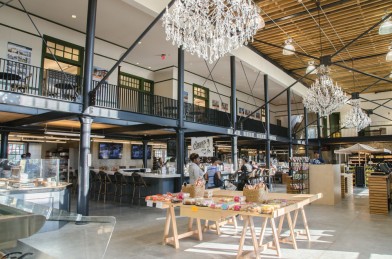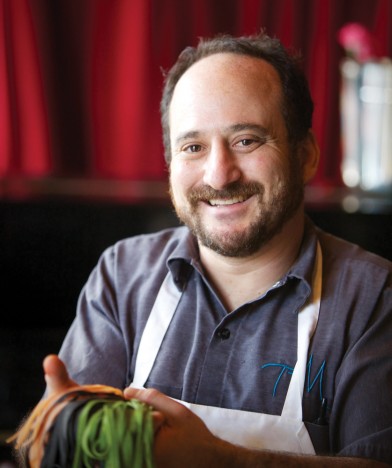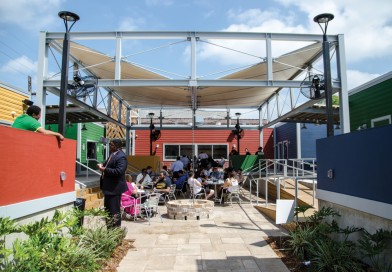When the St. Roch Market opened in 2015, Councilmember-at-Large Jason Williams heralded the Landrieu administration capital project for “providing a necessary service to the surrounding neighborhoods,” and called it “an example of how community input can enhance public projects.” Though the market has become a great destination for locals and visiting foodies, it would be a stretch to say it’s filling the neighborhood’s “food desert” void with affordable groceries.
A year later in Central City, however, the Dryades Public Market is doing what many hoped would happen in St. Roch—and it’s not alone. The food and beverage boom that’s cropped up on Oretha Castle Haley Boulevard now features a diverse array of concepts, menus and price points, giving it a unique profile at an explosive time for restaurants in New Orleans. And while redeveloped corridors like Freret Street are starting to welcome new-construction residences that boast all the trappings of gentrification, Oretha Castle Haley has managed to balance community-focused food and beverage options with higher-end fare. The combination means more foot traffic for what was once a busy, commerce-heavy main street and more awareness, city-wide, about a historic neighborhood.
Located in the former Myrtle Banks Elementary School building at 1307 Oretha Castle Haley Boulevard, Dryades Public Market celebrated its grand opening in April after a slow ramp-up during which its name changed from Jack & Jake’s and its leadership shifted from original CEO John Burns to Chef Daniel Esses, one of the owners of Three Muses on Frenchmen Street. Buzz around the market has proliferated for more than a year, in part because of the cost and initial scope of the project, which Esses reined in when he took over at the end of August. Rather than withhold the space from public use any longer, he opened the doors in September, launching individual components like the coffee bar and sandwich counter as they became ready for business. Now, the market is starting to come to life.
“We brought in Associated Grocers to help us give it the look of a grocery store, including products at an affordable price. Then we also brought in people who specialize in what they do, such as bakers and butchers,” said Esses, who’s been vocal about his commitment to keeping reasonably priced fresh foods available for the community.
Its namesake is the Dryades Market, which opened across the street in 1849, long before the street was renamed in honor of civil rights worker Oretha Castle Haley. (A 1960 boycott of Dryades Street merchants who refused to hire black employees is considered a keystone of the city’s early freedom struggle and an important aspect of the neighborhood’s rich history.)
Today’s Dryades Public Market offers fresh and mostly local produce, meat, seafood, canned goods and dairy products, mostly at Rouses-level prices.
Prepared sandwiches, salads and a coffee bar; Esses’ fresh pasta shop; seafood courtesy of Curious Oyster (which relocated from the St. Roch Market) and a full wine and booze bar are also available inside the spacious and sunny three-floor building. Outside by the parking lot, peas, squash, herbs and fig trees make up a young, “edible landscaping” garden.
The market’s top floors are currently a mix of offices and open space that has been used for events like a recent juried art exhibit. On June 1, Cochon Butcher alum Leighann Smith, who runs the market’s meat program, is offering a $5 class on sausage making featuring Mississippi-raised pork.
“It’s a balance between giving people the yin and the yang,” said Esses. “We sell artisanal bread and cake but then you also have something way less hardcore. If they want that and they can afford it it’s available. If [customers] want something with ten ingredients instead of 100, we have that too.”
During a visit after Jazz Fest in May, the market’s first floor was peppered with a handful of shoppers perusing massive $3 bags of locally grown kale and equally enormous local cauliflower priced at $4 apiece. There were also folks working on laptops or trickling in from offices on the boulevard to enjoy a $5 glass of happy hour wine at Bar 38, which is situated in the center of the market next to the raw and coffee bars. Small plates like seared yellowfin tuna marinated in a spicy soy vinaigrette with olives and oranges ran for $8 on the bar side, while diners slurped a mix of local and imported oysters ($1 to $2 during happy hour), crab claws, hush puppies and tangy pickled shrimp on the Curious Oyster side.
In May, Esses was in the process of hiring a community outreach liaison whose role would be to ensure the market was meeting the needs of the neighborhood. The Dryades group also seems to have both the mayor’s office and City Councilwoman LaToya Cantrell on its side (Esses cited Cantrell’s efforts to help bring a local farmer’s market to the store on Saturdays as an example of her advocacy there).
Asked if he sees Oretha Castle Haley as a foodie destination, Esses was optimistic.
“I always believe the more restaurants on one street, the better,” he said.
“Competition is good for the restaurant business, not bad. I want us to help bring business to the other businesses. Oretha Castle Haley still needs more foot traffic and more attention.”
Efforts are underway to make that happen. On May 6, the Oretha Castle Haley Boulevard Merchants & Business Association launched its inaugural First Fridays event, featuring happy hours, live music and extended gallery hours at participating venues. Although the event got off to a slow start, spots like the patio at Roux Carré were bustling by sunset as diners sampled ceviche and pupusas from the Pupusa Lady, po-boys and gumbo from Estralita’s Express, jerk and curry chicken from Johnny’s Jamaican Grill, cochon de lait po-boys from the Splendid Pig and fresh-squeezed juices from the Youth Empowerment Project’s Juice Box stall.
Roux Carré also recently opened a bar booth that features daily half-price happy hour specials. This summer, the space plans to feature live music two to three days a week.
Like the market, Roux Carré was created with an eye to serving the community in a unique way. Phyllis Cassidy’s non-profit group the Good Work Network opened Roux Carré in November as an incubator for local restaurant entrepreneurs. Its current vendors all took classes in restaurant management and financial planning through the Good Work Network, which also provided them with business mentors.
“I first found out about Roux Carré from an article in the Times-Pic about two and a half years ago and we pretty much applied right away,” recalls Jennifer Sherrod-Blackwell, who runs the Splendid Pig with her husband, Brandon Blackwell.
After the Blackwells were accepted into the program, construction delays prevented Roux Carré from opening as scheduled. During that time, the couple took over Curious Oyster’s former space at St. Roch Market with their other business, Elysian Seafood.
“I love being in both spaces, but they are completely different,” Sherrod-Blackwell said. “The Roux Carré is sort of a warmer, inviting and relaxed atmosphere. What’s happening with live music makes it more of an experience rather than just dining. Also, Roux Carré is drawing people in from the neighborhood and the community as the solid base of our customers. St. Roch draws people not only from all over the city but from all over the country.”
In addition to the cochon de lait po-boy, Splendid Pig offers a blue crab cake and “pork-a-mein,” a lemongrass-braised pork over rice noodles with cilantro and pickled vegetables. The menu features a salad of fresh Louisiana strawberries and goat cheese with a pepper jelly vinaigrette and crispy bacon, plus homemade pork jerky and three different kinds of dark chocolate brownies.
“We source a good bit of our produce from the Dryades Market up the street and from Hollygrove [Market] and we use local rice,” Sherrod-Blackwell said. “Anything that we can reasonably source locally we do.”
Vendors sign a one-year lease that’s then made available for renewal, Sherrod-Blackwell said.
“They don’t want to force anyone to leave,” she added, “but they also want to let people leave if they’re not being profitable and growing their business.”
There are no formal mandates regarding menu prices, but the Good Work Network encourages vendors to keep prices at a level Central City residents are likely to find reasonable, she added.
Linda Pompa, the Executive Director of the Oretha Castle Haley Boulevard Merchants & Business Association, says her organization encourages similar thinking when new businesses move into the neighborhood.
“Private property is private property, but we have the intelligence about what people want in the neighborhood,” Pompa explained, noting the importance of encouraging more foot traffic.
The push to redevelop the neighborhood began in the ’90s, but it didn’t start gaining real steam until after Hurricane Katrina. The strip was designated as a Louisiana Main Street in 2006 and a Cultural Products District in 2008, both of which helped revitalize the region. The New Orleans Redevelopment Authority has also pitched in with funding pegged to construction and building facades up and down the street.
In sum, Pompa said, “a combination of non-profit, public, philanthropic and private investment, especially post-Katrina, along with specific planning since around 2000 has helped push the neighborhood forward.”
In May, the street was notified that it will receive a state-wide Main Street Award from the Louisiana Culture Awards.
Uptown-based realtor Jean-Paul Villere says the corridor was long seen as an inner-city stretch that was “harder to put on the public radar,” making it slower to revitalize than Freret Street, which he says had the advantages of being closer to Tulane and Loyola and mostly shuttered after the storm. The liquor license moratorium along the boulevard was another factor.
“O.C.H., while dry, had a decent population, but in non-profits,” Villere said in an email. “Whereas Freret was basically a blank canvas, O.C.H.’s occupancy and distance from the newer blood revitalizing the city placed its resurgence to the last little while. Prices are of course relative but they’re higher than they’ve ever been—not Magazine [Street]-high, of course.”
Pompa points out that the proliferation of non-profits along the boulevard has helped keep new businesses coming in to remain focused on the community. Organizations like the Good Work Network or Café Reconcile, which since 2000 has offered weekday New Orleans–style lunches prepared and served by job training program participants from at-risk communities, have invested in the neighborhood and won’t be forced out by rising rents.
“What has kept it from turning into Freret Street is that so many buildings here are owned by non-profits,” Pompa said.
While Café Reconcile was the first restaurant to open along the boulevard long after its heyday, Pompa says Casa Borrega was a catalyst of sorts for the eventual proliferation of food-focused venues in the corridor.
Hugo Montero and his wife Linda Stone opened their Mexico City street food–inspired eatery and live music venue in 2013 as a Benefit Corporation—a for-profit business whose goals include creating what Wikipedia describes as “a positive impact on society, workers, the community and the environment.”
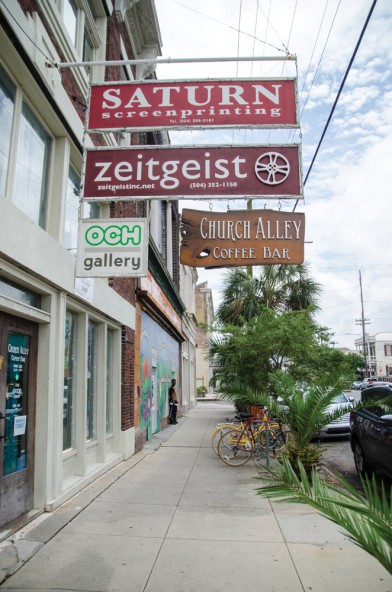
Church Alley Coffee Bar, sharing space with Zeitgeist, is one of the best coffee shops in the city.
Photo by Renee Bienvenu
Decked out with a vast array of artwork and knickknacks, Casa Borrega hosts Latin cultural events and features jazz, Latin and funk bands, plus singer-songwriters, both inside by the main bar and outside on the patio. There’s also a steady stream of movie and event-goers from the Zeitgeist theater across the street, as well as the coffee bar, Church Alley, which occupies the Zeitgeist’s front space.
Dishes at Casa Borrega range from traditional central Mexican options to creative spins on apps like a deep-fried cauliflower. This summer, they’re working towards the launch of a Cuban food truck program called La Cubana.
“When we moved in we used to walk our dog where the NORA building is now and it was like the wilderness,” Stone recalled. “It was kind of fun—we were like in this outpost.”
That’s obviously no longer the case. Chef Adolfo Garcia and his partners Ron Copeland and Jared Ralls opened Primitivo at 1800 Oretha Castle Haley Boulevard. The building was previously a daycare center downstairs and apartments upstairs. According to Copeland it was “gutted down to the studs” and completely renovated to make room for the meat-heavy, open hearth–focused restaurant, which offers happy hours, but generally has a higher price point than other dining options in the area. Drink prices, however, remain relatively low for a restaurant of Primitivo’s caliber.
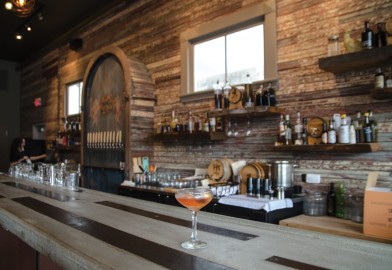
If you haven’t checked out Primitivo yet, you should at least stop by for a cocktail.
Photo by Renee Bienvenu
“For the cocktail program, I have a two rules: Drinks should take 45 seconds or less to make and we have to be able to charge $9 or less with named liquor,” Copeland said in an email.
“It really upsets me when I see a cocktail menu with well liquor as the main ingredient and it’s $10–$12. It’s stealing from the customer, plain and simple.”
Chef Ryan Hughes’ contemporary Southern–inspired Purloo, which opened down the street in January 2015, also features higher prices. But the open kitchen and the restaurant’s location inside the Southern Food and Beverage Museum give it an interesting twist.
Liz Williams founded the museum as a way to combine her interest in historical food culture with her experience launching institutions like the Ogden Museum of Southern Art and the World War II Museum. She says she moved “SoFAB” to Central City from its initial location on the Riverwalk for a number of reasons, but the food history aspect of where they ended up now plays a key role in the museum’s identity.
“We went into that neighborhood because it was affordable and because it was accessible by bus and streetcar. Once we were there, though, we selected the building that was the Dryades Market,” she explained. “So then that building becomes our largest artifact because we’ve saved this building that really does represent something about the food and culture of New Orleans.”
SoFAB’s tenant Purloo was selected with an eye to Hughes’ plan to showcase cuisine that highlights “regional foodways,” complimenting SoFAB’s exhibitions.
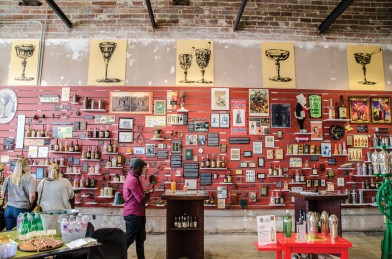
Once you’re done browsing the Southern Food and Beverage Museum’s exhibits, you can grab a bite at the attached restaurant, Purloo.
Photo by Renee Bienvenu
In addition to gallery displays, the museum offers interactive cooking demos and a summer camp for kids. It also operates the John & Bonnie Boyd Hospitality & Culinary Library at 1609 Oretha Castle Haley Boulevard, which features more than 11,000 volumes of archival information about food history and culture.
Looking ahead, Pompa says she’s unaware of any new food projects opening on the boulevard in the next four to six months. She points out, though, that the general public is still in the process of discovering some of the neighborhood newcomers, like Filipino chef and Paul Prudhomme protégé Crispin Pasia’s CK’s Hot Shoppe at the corner of Martin Luther King Boulevard and Baronne Street, or Brady’s Wine Warehouse on the strip’s downtown end.
In the meantime, the new burst of food-related activity on Oretha Castle Haley Boulevard continues to draw a healthy mix of members of the Central City community and curious diners from the surrounding city and further away.
Villere, who’s been watching Central City spring back to life since the storm, muses, “OCH’s golden years are still ahead of it.”

